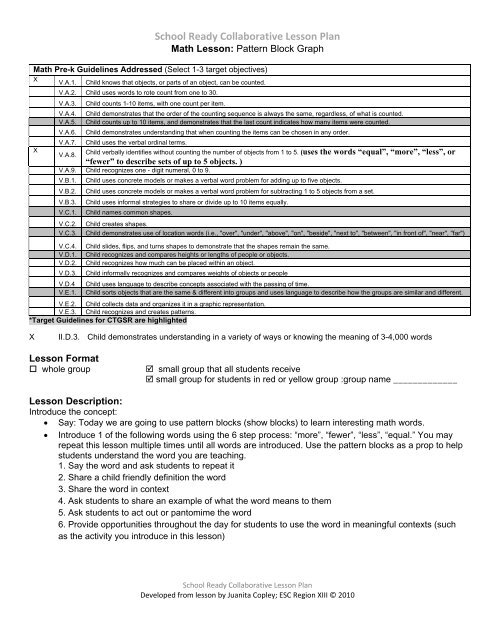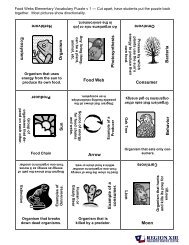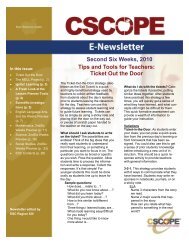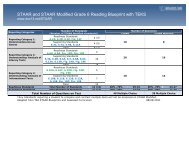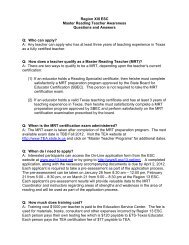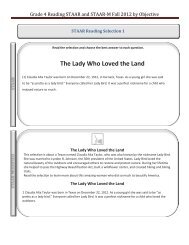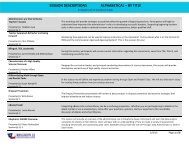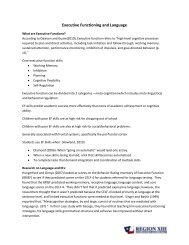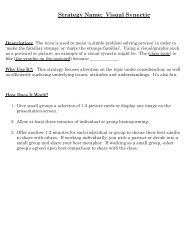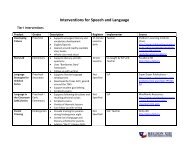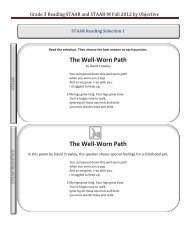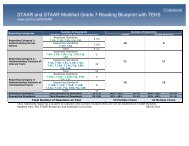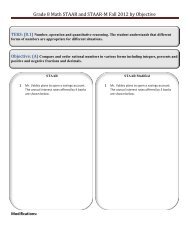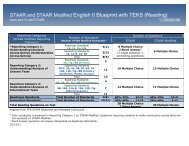School Ready Collaborative Lesson Plan - Region 13
School Ready Collaborative Lesson Plan - Region 13
School Ready Collaborative Lesson Plan - Region 13
You also want an ePaper? Increase the reach of your titles
YUMPU automatically turns print PDFs into web optimized ePapers that Google loves.
<strong>School</strong> <strong>Ready</strong> <strong>Collaborative</strong> <strong>Lesson</strong> <strong>Plan</strong>Math <strong>Lesson</strong>: Pattern Block GraphMath Pre-k Guidelines Addressed (Select 1-3 target objectives)XXV.A.1.Child knows that objects, or parts of an object, can be counted.V.A.2. Child uses words to rote count from one to 30.V.A.3.V.A.4.V.A.5.V.A.6.V.A.7.V.A.8.Child counts 1-10 items, with one count per item.Child demonstrates that the order of the counting sequence is always the same, regardless, of what is counted.Child counts up to 10 items, and demonstrates that the last count indicates how many items were counted.Child demonstrates understanding that when counting the items can be chosen in any order.Child uses the verbal ordinal terms.Child verbally identifies without counting the number of objects from 1 to 5. (uses the words “equal”, “more”, “less”, or“fewer” to describe sets of up to 5 objects. )V.A.9. Child recognizes one - digit numeral, 0 to 9.V.B.1.V.B.2.V.B.3.V.C.1.V.C.2.V.C.3.V.C.4.V.D.1.V.D.2.V.D.3.V.D.4V.E.1.Child uses concrete models or makes a verbal word problem for adding up to five objects.Child uses concrete models or makes a verbal word problem for subtracting 1 to 5 objects from a set.Child uses informal strategies to share or divide up to 10 items equally.Child names common shapes.Child creates shapes.Child demonstrates use of location words (i.e., "over", "under", "above", "on", "beside", "next to", "between", "in front of", "near", "far")Child slides, flips, and turns shapes to demonstrate that the shapes remain the same.Child recognizes and compares heights or lengths of people or objects.Child recognizes how much can be placed within an object.Child informally recognizes and compares weights of objects or peopleChild uses language to describe concepts associated with the passing of time.Child sorts objects that are the same & different into groups and uses language to describe how the groups are similar and different.V.E.2. Child collects data and organizes it in a graphic representation.V.E.3. Child recognizes and creates patterns.*Target Guidelines for CTGSR are highlightedXII.D.3. Child demonstrates understanding in a variety of ways or knowing the meaning of 3-4,000 words<strong>Lesson</strong> Format whole group small group that all students receive small group for students in red or yellow group :group name _____________<strong>Lesson</strong> Description:Introduce the concept: Say: Today we are going to use pattern blocks (show blocks) to learn interesting math words. Introduce 1 of the following words using the 6 step process: “more”, “fewer”, “less”, “equal.” You mayrepeat this lesson multiple times until all words are introduced. Use the pattern blocks as a prop to helpstudents understand the word you are teaching.1. Say the word and ask students to repeat it2. Share a child friendly definition the word3. Share the word in context4. Ask students to share an example of what the word means to them5. Ask students to act out or pantomime the word6. Provide opportunities throughout the day for students to use the word in meaningful contexts (suchas the activity you introduce in this lesson)<strong>School</strong> <strong>Ready</strong> <strong>Collaborative</strong> <strong>Lesson</strong> <strong>Plan</strong>Developed from lesson by Juanita Copley; ESC <strong>Region</strong> XIII © 2010
Introduce the activity: Say: Since you are so smart and now understand the word ____ (more, fewer, less, equal) you’re goingto play a game with your friends to see who has ___ (more, fewer, less, equal) red pattern blocks andwho has ___ (more, fewer, less, equal) green pattern blocks, etc… Say: To play, close your eyes and draw out one pattern block from the container. Be sure to take only1. (demonstrate) Say: Next, color the square on your graph that is the same color as your pattern block. What color did Iget? So, I will color the ____ square at the bottom of my graph. (demonstrate) Then I get to drawagain! (demonstrate) Say: Keep drawing pattern blocks and coloring squares until you have filled in 1 column of your graph.Demonstrate: purposefully draw out pattern blocks of the same color so that you can quickly fill up 1column on your graph. Say: When you have four blocks filled of any color, stop. Say: Now let’s see how I did. Practice using all vocabulary words students have learned so far- “more”,“fewer”, “less”, “equal”- to analyze graph. Say: I can also compare my graph to a friend’s graph! Practice using all vocabulary words students have learned so far- “more”, “fewer”, “less”, “equal”- tocompare graph you just completed to a graph you completed prior to this lesson (“a friend’s graph.) Options: instruct students to circle the color that has more colored squares than the other colors andput and X over the color that has fewer or less colored squares than the others. Explain your expectations for what children should do once they complete their work. While students work, teachers can ask the following inquiry questions and record data on students’understanding.How many ___ colored squares do you have?Which color has more? How do you know?Which color has fewer/less? How do you know?Do any colors have equal numbers of colored squares?After students have successfully completed this activity with teacher assistance, place it in a center.Materials Containers of pattern blocks (1 container for each group of 2-4 students) Container of colored pencils, crayons, or markers with amble utensils in the primary colors (1 containerper table) Pattern Block Graph ( 1 per student) 1 graph already completed with 1 column filled to the top and the other columns with some squaresfilled in. You will use this graph when you make comparisons during the lesson.<strong>School</strong> <strong>Ready</strong> <strong>Collaborative</strong> <strong>Lesson</strong> <strong>Plan</strong>Developed from lesson by Juanita Copley; ESC <strong>Region</strong> XIII © 2010
Name _________________________________________Pattern Block Graph<strong>School</strong> <strong>Ready</strong> <strong>Collaborative</strong> <strong>Lesson</strong> <strong>Plan</strong>Developed from lesson by Juanita Copley; ESC <strong>Region</strong> XIII © 2010


